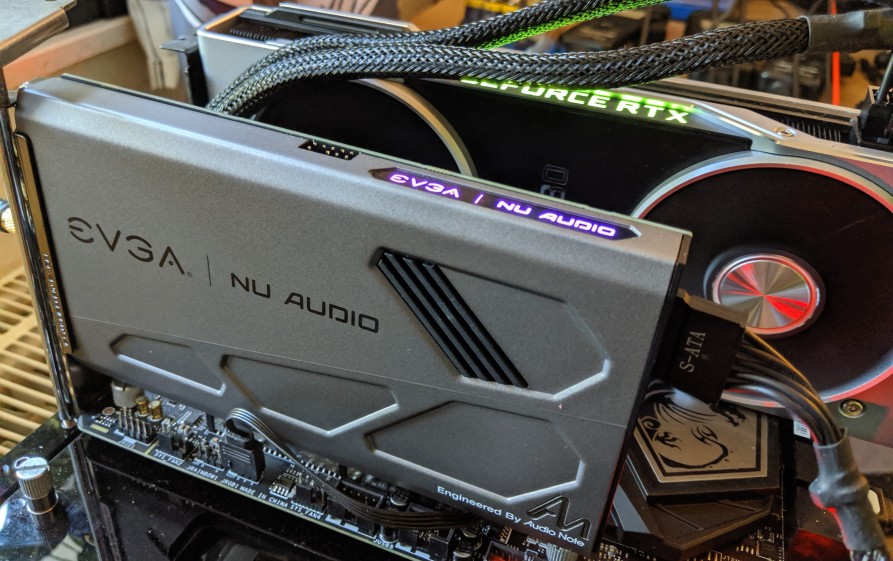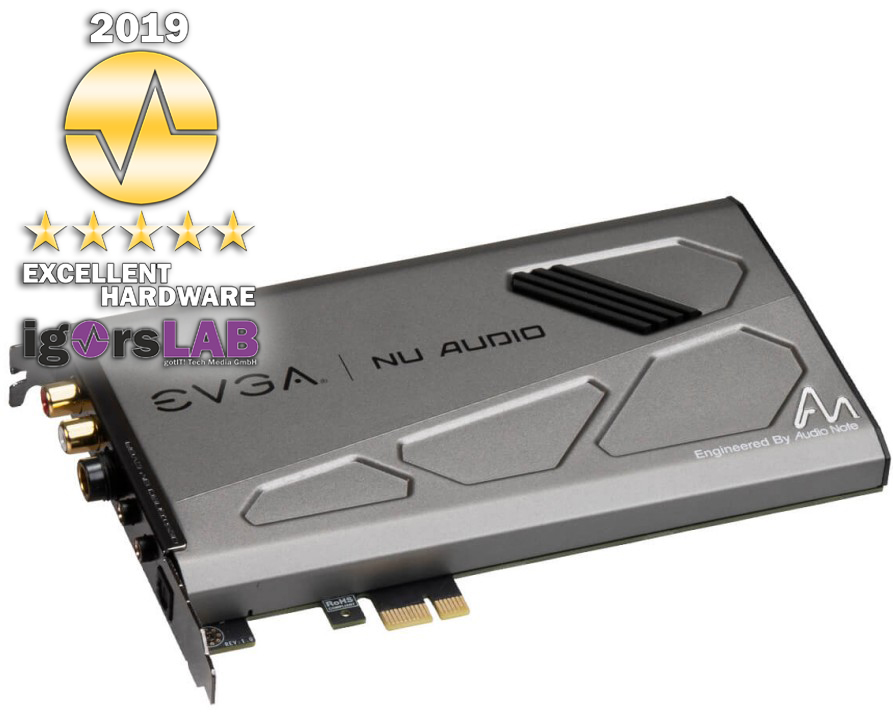Listening experience and subjective sound assessment
The one with the interchangeable op-amps in the audio branch is more voodoo, but apparently a must-have nowadays. The built-in TI chips are outside of any criticism and whether a really audiophile Schöngeist puts such a card into the PC, if he has one at all, may also be left open. The rest of the cash-rich audience won't worry about this feature. Because the NU Audio from EVGA really plays in the Bundesliega. And the way it was delivered.
The level reserves are quite brutal for such a plug-in card, even if one could have guessed it already on the basis of the specs. And it doesn't really distort anything to the limit, the klirr starts abruptly without announcing itself big. Technically logical, because the card limits, depending on the impedance, either at current or at the output voltage. At some point, it just doesn't go any further. Except that you shouldn't be bothered with these borderline experiences or your own hardware.

I tested the sound with different headphones, from the rather cozy Beyerdynamic Amiron Home to the rather pretentious T1 and the Sennheiser GSP 600 down to a rather deaf Roccat NOZ from the gaming shelf. It was never possible for me to identify the sound card as a falsifying link in the transmission chain. The sound of the headphones was exactly as I had it in my ear from the A20 as a test amplifier, which of course makes the assessment all the more difficult.
When I plug the T1 back and forth on the A20, there is hardly any difference. In direct comparison to an Asus Xonar Essence STU, however, I like the sound of the EVGA Nu Audio one tick better, because the reserves are significantly higher and the possible dynamics slay smoothly and also because the strand with the DAC is absolutely sovereign. Works. This is now easy mockery at the highest level and without direct comparison you will never notice it.
Even in the quiet tones, it never has the slightest hint of a rather cool and reserved ambience, but there is simply fire in it, if you play neat material and have suitable headphones. I really like this style of play, because it also allows emotions.
Microphone Performance
If there was anything to complain about, it is the separately controlled microphone input, which has an enormously high amplification potential without causing waterfall-like noise, but the voices do not sound 100% natural. That's why I had fun and examined individual frequency ranges separately. I noticed that the rather metallic pointed-sounding impression comes from the area of the upper middle swell and especially the high tone.
The sibilants are a tick too hard and too concise – you can already notice at the end that the chip of Cirrus Logic is more than just a simple preamplifier. None of this is detrimental to speech reproduction, and the normal consumer is more likely not to hear this or even find it good. That's why I don't detract from a point here, because the line-in is really impeccable.
Summary and conclusion
Not cheap, but worth the price. This time you can put it so short and crisp. What you think you need for gaming solves the software, whether it's virtual surround sound or the whole RGB lighting. You can bring the lumens to zero and simply put the whole RGB firlefanz on war blackout: the paint is finished. Speaking of firlefanz. Even if you've taken on the usual gaming hyper-mega-dragon design for the software's optics, it's just what's really needed in features.
I have the utmost respect for this, because the risk of getting lost here in silliness is very high (see Sennheiser and especially Creative). Lots of colorful buttons and pointless functions or Sound games can never replace solid hardware. And that's why I like NU Audio, even if I personally don't stand on plug-in cards. The thing is not quite cheap, but honest. This is done with gaming as a side job, which the card can also cancel without any problems at the push of a button. Thank you for that!

And otherwise? The workmanship is excellent, the built-in components are too. And the circuit layout also shows, then one has not superficially expensive, but above all carefully equipped. This is also the experience of Audio Note, because you are quickly tempted to do too much of the good. This card, on the other hand, is an honest announcement and therefore ideal for those who prefer a clean sound to the usual gaming fairs and still do not want to do without the mask ball.
However, I have two small criticisms. That with the transients is such a thing that is actually superfluous if you had tested it. What use are great internal values with programs like RightMark's Audio Analyzer when the graphics card next door makes the nasty beam man? It's not extreme and inaudible if you don't know, but all my external solutions can do it a touch better. That you only get 7.5 instead of the 8 volt RMS, as a gift. To criticise that would be awkward. But that with the microphone and the "electric" overtone is at least unnecessary, even if no one will hear it at All in Teamspeak.
And as a conclusion? product, almost without quirks. You have to get that right away.
EVGA NU Audio 5.1, PCIe x1 (712-P1-AN01-KR)
































Kommentieren